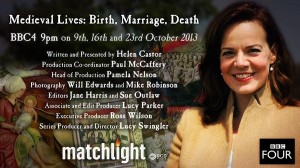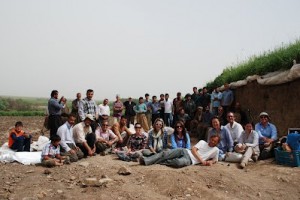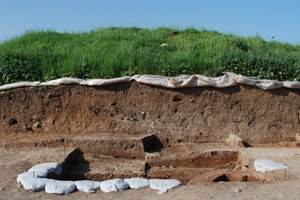Interested in Anglo-Saxon Glastonbury? Then get yourself to the Institute of Archaeology in London for The David Wilson lecture in Medieval Studies, at 5.30pm on Wednesday 16th October, lecture Theatre G6. Roberta will be speaking on the subject of: Glastonbury Abbey: Reinterpreting the Anglo-Saxon Archaeology. This will be followed by a launch party for the seminar series in the staff common room there.
Professor Roberta Gilchrist to appear on TV!
A new television series on BBC4 entitled ‘Medieval Lives: Birth, Marriage and Death’ starts tonight (Wednesday 9th October) at 9pm. The first programme looks at birth, the second (16/10/13) marriage and the last (23/10/13) death. Our very own Professor Roberta Gilchrist (who is also Head of the School of Archaeology Geography and Environmental Science) is to appear in episodes 1 and 3. Not to be missed!
National Student Survey Results 2013
Great news for our department!
The NSS results for 2013 have now been published. The results for Archaeology are excellent, with 100% student satisfaction for the fourth year running!
We are nationally in the top 25% for our subject area with scores of: 98% for teaching quality, 94% teaching support, and 93% for organisation and management.
http://www.thestudentsurvey.com/
Here’s the data for our BA course:
http://unistats.direct.gov.uk/Subjects/Overview/10007802FT-UFARCHBA
and our BSc:
http://unistats.direct.gov.uk/Subjects/Overview/10007802FT-UFARCHBSC
Aleks reports on a tonne of data in Poland!
Over the last three weeks a joint UK-Polish team have been excavating the Prussian stronghold of Swieta Gora (sacred hill) in Masuria, north-east Poland, within the framework of the Ecology of Crusading project.
 The main focus of the excavation, now in its third season, has been the embankment at the northern end of the site, which was always assumed to be be early medieval.
The main focus of the excavation, now in its third season, has been the embankment at the northern end of the site, which was always assumed to be be early medieval.
It turns out the embankment is 17th century, but underneath there are preserved occupation layers and features from the last phase of Prussian tribal settlement at the site, just before the region was overwhelmed by the Teutonic Order’s crusades in the 13th century.
We’ve recovered a tonne of cultural and environmental data, with evidence for the exploitation of species such as bison and auroch. Last week photographer Magnus Elander was documenting the excavation and surrounding landscape as part of our outreach programme.
Keep up-to-date with the excavations on the team’s Facebook page
Hominid dispersal and the Indian Monsoon. A new project for our Palaeoclimate expert.
The modern vast desert belts of Northern Africa and Arabia are very hostile environments and thus a natural barrier for humans and mammals. A successful dispersal was only possible at times when the desert turned into a savannah-type landscape with abundant lakes.
To date, our knowledge of past climate variability in Arabia is very limited due to a distinct lack of suitable climate archives. Fortunately stalagmites collected from various caves on the Arabian Peninsula can now provide detailed and precisely-dated information on Quaternary climate variability back to several million years ago.
Based on previous investigations on stalagmites from Yemen and Oman, we know that stalagmite deposition is only possible during wet periods with rainfall above at least 300 mm per year (present-day average rainfall in the desert is generally less than 100 mm year). However, the current limit of the dating method (Uranium-Thorium dating) is 500,000 years, whereas dispersal of hominids took place between approx. 2-1 million years before present.
For this study, funded by NERC, Dominik Fleitmann and Stuart Black will use a fairly new method (Uranium-Lead dating) for dating very old stalagmites covering this crucial time interval in human history. By dating periods of stalagmite deposition precisely we can identify these periods and establish links between dispersals of hominids and mammals.
Read an article on speleothems (stalagmites and stalactites) in Science Magazine
Two of our students take up positions the British Museum
![]() Two of our current PhD students have been appointed to prestigious positions at the British Museum.
Two of our current PhD students have been appointed to prestigious positions at the British Museum.
Rosie Weetch is just about to complete her PhD on Late Saxon brooches (supervised by Dr Gabor Thomas & Hella Eckardt) and has been working as a project curator at the British Museum since 2012, helping to design the new early medieval gallery and in particular researching and displaying the famous Sutton Hoo treasure.
Helen McGauran will submit her thesis on the circulation of Bronze Age soft-stone artefacts in Bahrain and Cyprus (supervised by Dr Wendy Matthews & Stuart Black) this June, before starting as Project Curator on the Zayed National Museum Project.
Her role is to carry out targeted research into topics and key sites to support the Interpretation team in presenting information on the archaeology of Abu Dhabi and the United Arab Emirates from early prehistory up until the end of the pre-Islamic period, within the new Museum in Abu Dhabi. She will also be involved in some aspects of artefact and other object selection.
Lyminge Project Report for 2012 Season Published
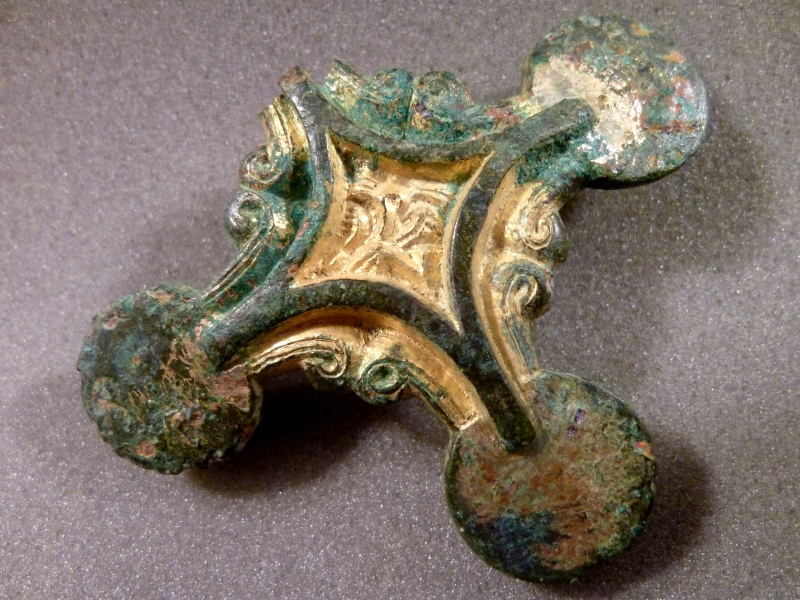
Harness mount uncovered in the 2012 excavations
We’re pleased to announce that the interim report for the excavations that took place in the summer of 2012 on Tayne Field is now available for all to download on the Lyminge Archaeological project website: Lyminge 2012 – Interim report (PDF 3.43MB.
The report provides a detailed summary of the archaeology excavated last summer and summarises the major Anglo-Saxon discoveries, including the royal feasting hall, as well as the important Mesolithic and Norman-period archaeology. It is illustrated with detailed site plans and a wide selection of colour photos of finds and features and the site under excavation.
Work continues at the site over this summer and in 2014 in order to expand understanding of the development and extent of the archaeology under Tayne field. Work will be reported on the Lyminge blog: http://blogs.reading.ac.uk/lyminge/
Further published reports and previous interim reports from the project are available on the website (www.lymingearchaeology.org).
Exciting Neolithic finds in the Fertile Crescent
Staff and students from the University of Reading, as part of the Central Zagros Archaeological Project (CZAP), have returned from a successful six-week field season at Bestansur, in the Kurdish Region of Iraq. The site lies close to a perennial spring and comprises extensive Early Neolithic occupation and later Neo-Assyrian and Sasanian levels, which form much of the 7.5m high central mound.
Excavations in 2012 established that Early Neolithic deposits were preserved across a 100-by-50 metre area, including pisé walls, areas of food preparation, flint-knapping, and a double-burial of a man and woman buried head-to-toe.
This season, CZAP excavated five trenches, including cutting a 15-metre section into the north of the mound. This work has yielded the first glimpses into the core of the Neolithic settlement with fine plaster surfaces, layers of dung and ochre, comparable with Neolithic sites across the region, such as Çatalhöyük.
Extensive post-excavation analysis is now under way examining issues of plant and animal domestication, resource usage and cultural networks across the Fertile Crescent.
Further details can be found on:
Read about the project leaders
Read a report from the Archaeology 3D project on their collaboration with CZAP
Towns of Roman Britain Conference to be hosted at Reading
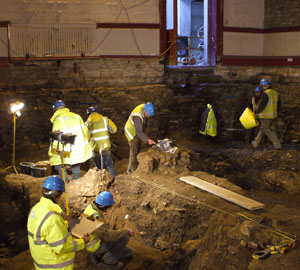 A day conference, aimed at academics, professional practitioners and others with an interest in all aspects of Romano-British urbanism, will focus on the contribution of commercial archaeology to the study of the major Romano-British towns (coloniae and civitas capitals) will take place at the University of Reading on 30 November 2013.
A day conference, aimed at academics, professional practitioners and others with an interest in all aspects of Romano-British urbanism, will focus on the contribution of commercial archaeology to the study of the major Romano-British towns (coloniae and civitas capitals) will take place at the University of Reading on 30 November 2013.
Discussion will look at historic towns of England which have seen significant commercial work, as opposed to the largely greenfield where this is not the case.
The papers will be published in a volume edited by Michael Fulford and Neil Holbrook in 2014.
The conference is organised in collaboration with English Heritage, Cotswold Archaeology and the Society for the Promotion of Roman Studies
Professor Steve Mithen on the Beeb!
Professor Steven Mithen contributed prominently to a BBC Two ‘Culture Show Special: Ice Age Art’ which was first screened on Saturday 9th February. It can be watched on the BBC I-Player (see the link below).
The programme introduces a major exhibition at the British Museum on Ice Age Art from 7 February to 26th May 2013.
View on BBC iplayer. The programme is available to view until 6:29pm Saturday, 16 Feb 2013.
Find out more about the exhibition
Read about Professor Steve Mithen


